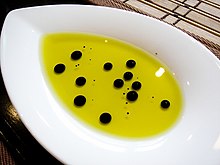Phase separation



Phase separation is the creation of two distinct
immiscible liquids, such as oil and water. This type of phase separation is known as liquid-liquid equilibrium. Colloids
are formed by phase separation, though not all phase separations forms colloids - for example oil and water can form separated layers under gravity rather than remaining as microscopic droplets in suspension.
Phase separation in cold gases
A mixture of two helium isotopes (helium-3 and helium-4) in a certain range of temperatures and concentrations separates into parts. The initial mix of the two isotopes spontaneously separates into -rich and -rich regions.[2] Phase separation also exists in ultracold gas systems.[3] It has been shown experimentally in a two-component ultracold Fermi gas case.[4][5] The phase separation can compete with other phenomena as vortex lattice formation or an exotic Fulde-Ferrell-Larkin-Ovchinnikov phase.[6]
See also
References
Further reading
- Khabibullaev PK, Saidov A (April 2013). Phase Separation in Soft Matter Physics: Micellar Solutions, Microemulsions, Critical Phenomena. Berlin Heidelberg: Springer. ISBN 978-3-662-09278-1.


